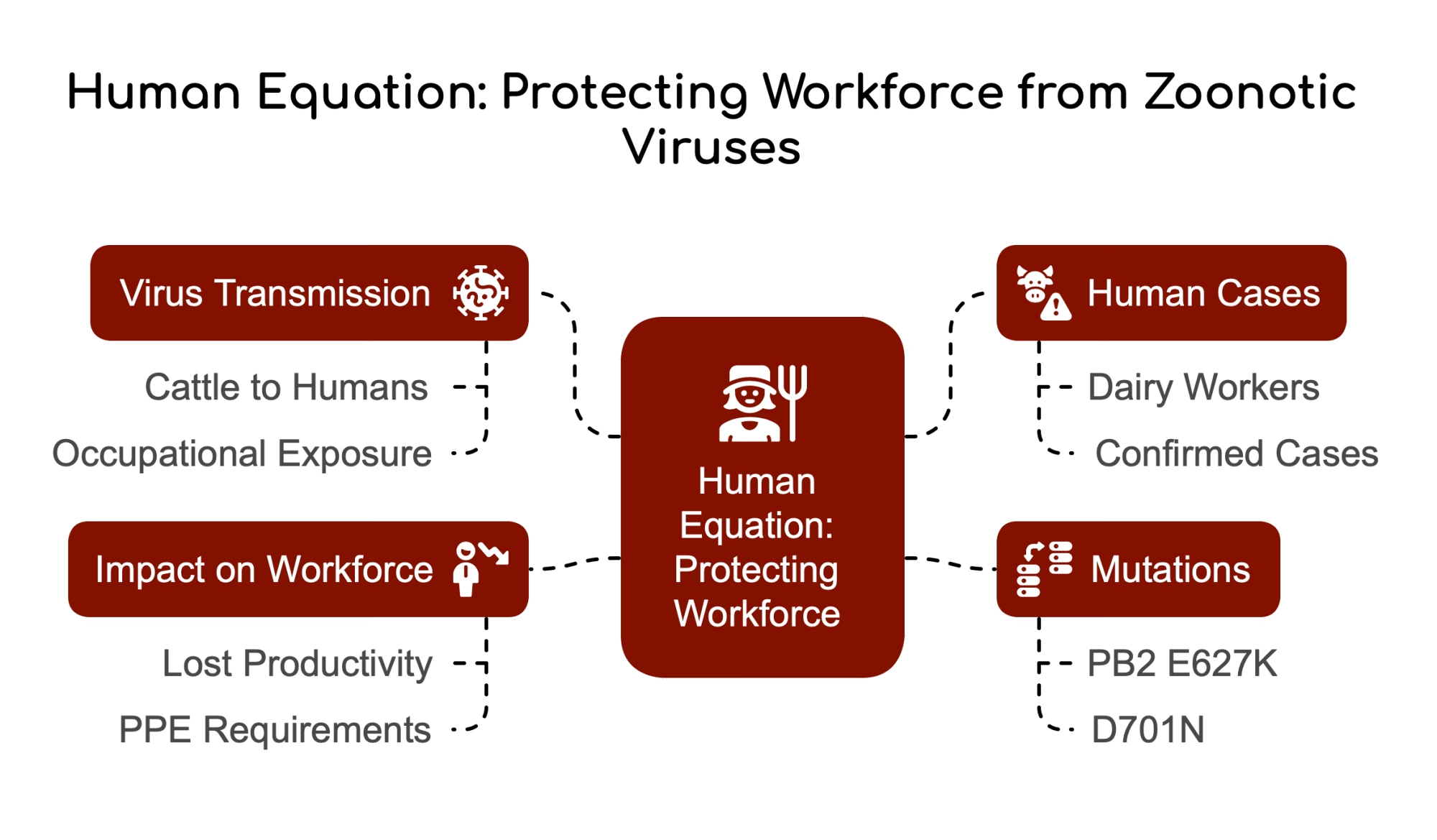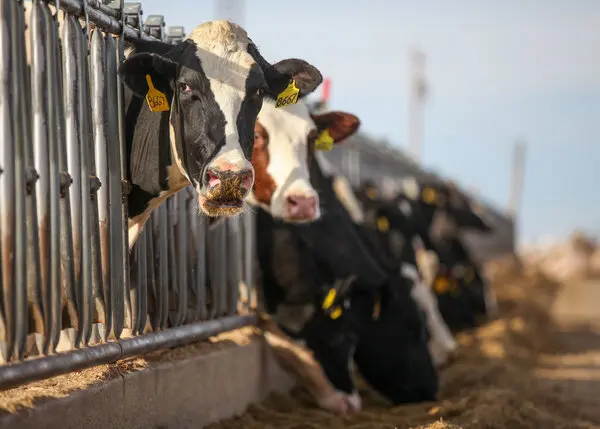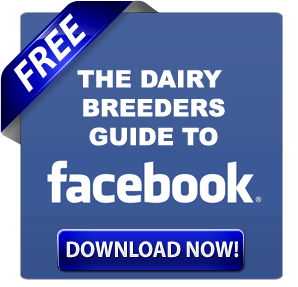H5N1 invades US dairy: 1 year later, the virus adapts, spreads, and challenges farmers. Key insights inside.
EXECUTIVE SUMMARY: The HPAI H5N1 virus has caused unprecedented outbreaks in U.S. dairy cattle since March 2024, driven by two distinct genotypes (B3.13 and D1.1) with mutations signaling mammalian adaptation. Transmission occurs primarily through contaminated milk, with high viral loads in mammary glands enabling rapid spread during milking. Economic losses exceed $700,000 per outbreak, impacting milk production and requiring costly biosecurity measures. While pasteurization ensures milk safety, raw milk poses zoonotic risks, with 70 human cases linked to dairy exposure. National surveillance and pre-movement testing aim to curb spread, but viral evolution in wild birds and cattle demands sustained vigilance.
KEY TAKEAWAYS:
- Dual Viral Threats: Two genotypes (B3.13 and D1.1) emerged via separate bird-to-cow spillovers, with mutations (PB2 E627K/D701N) hinting at mammalian adaptation.
- Milk as Super-Spreader: Virus concentrates in mammary tissue, turning milking equipment into transmission vectors—biosecurity must target parlors.
- $700K+ Herd Losses: Infected cows lose 901kg milk over 60 days; recovery includes prolonged yield drops and ELAP compensation limits.
- Zoonotic Wildcard: 41 dairy workers infected (mild cases), but no human-to-human spread—PPE and raw milk bans critical.
National Milk Testing: Surveillance via bulk tank/silo samples detected Nevada’s D1.1 outbreak early, proving its strategic value.

The battle against highly pathogenic H5N1 bird flu in U.S. dairy herds has reached a critical turning point. One year after the first case was confirmed in Texas, we now face a virus that’s smarter, more persistent, and more economically devastating than first anticipated. With over $700,000 in losses per outbreak and a virus demonstrating unprecedented mammary tropism, producers need immediate action plans—not just wishful thinking.
One year after Texas confirmed the first case of Highly Pathogenic Avian Influenza (HPAI) H5N1 in dairy cattle, the virus has transformed from a curious anomaly into a persistent industry-wide challenge. What experts initially dismissed as a fluke—a curious spillover from wild birds that would quickly burn itself out—has instead established itself as a formidable adversary across America’s dairy heartland.
THE BATTLEFIELD STATUS: WHO’S WINNING, WHO’S LOSING
“There hasn’t been a positive case of Influenza A in Texas since December,” reports Texas State Veterinarian Dr. Bud Dinges, providing a cautiously optimistic update from the outbreak’s ground zero. This indicates early containment efforts may be working in some regions, though the virus has shifted its focus westward.
“The virus is still affecting dairy herds in California, Nevada and Idaho,” Dinges adds, highlighting the virus’s westward migration pattern.
Kansas presents an even more encouraging picture. State Veterinarian Dr. Justin Smith credits aggressive testing and developing herd immunity for their improving situation: “Frankly, our dairies are clean and so, we don’t have the viral load out there pushing the virus into new dairies and susceptible species.”
This geographic shift follows scientific predictions. The virus tracks wild bird migratory pathways—nature’s perfect delivery system for an evolving pathogen.
“We’ve got four migratory fly-ways in the United States. They had the spillovers of the new genotype in Nevada and Arizona cattle. The virus is mutating and changing,” warns Dinges.
| State | Confirmed Herds (April 2025) | Peak Milk Loss | Key Risk Factors |
| California | 759 | 9.2% (Nov ’24) | High herd density, equipment sharing |
| Texas | 12 | 7.3% recovery | Early undetected spread |
| Nevada | 11 | 8.5% | New D1.1 genotype |
| Kansas | 4 | 0% (3mo clean) | Aggressive testing |
WHY THIS MATTERS FOR YOUR OPERATION: Your risk isn’t determined by national averages, but by your proximity to migratory pathways and regional dairy density. California operations face exponentially higher risk than those in the Midwest or Southeast based on current spread patterns.
THE ECONOMIC KNOCKOUT: REAL-WORLD COST TO YOUR DAIRY
“We lost almost $190,000 in 90 days from milk production drops alone,” reports Tom Hildebrandt, manager of a 950-cow California operation hit in October 2024. “That doesn’t include treatment costs, extra labor, or the cows we lost. And our bulk tank still hasn’t returned to pre-outbreak levels six months later.”
The comprehensive economic damage is staggering, with new research from Cornell University quantifying the devastation:
Per Cow Losses:
- 901 kg: Milk production lost per infected cow over 60 days
- 73%: Peak reduction in daily yield (from 35kg to just 10kg)
- $950: Estimated cost per infected animal
A study examining an Ohio herd of 3,900 milking cows found the 67-day outbreak cost over $737,500 in losses—and that’s without accounting for “reproductive adjustments, disruptions to milking time and other important labor considerations.”
Most troubling was the persistence of production losses. Unlike typical mastitis where recovery often means a return to normal, H5N1-infected cows didn’t bounce back to pre-infection yields even after 60 days of monitoring.
| Metric | Average Per Cow | California (759 herds) | ELAP Compensation |
| Milk Loss (60 days) | 901 kg | 683M kg total | $28,000 max |
| Treatment Costs | $950 | $721K/herd | 80% coverage |
| Culling Rate | 2% | 15,180 cows | $1,800/head |
WHAT THIS MEANS FOR YOUR BOTTOM LINE: The true cost extends beyond immediate milk loss. Plan for at least 90 days of production impact, with up to 25% of your affected cows never returning to their previous production levels. Budget accordingly.
TWO ENEMIES, ONE CRISIS: VIRAL GENOTYPES EXPLAINED
The dairy industry isn’t battling just one virus—it’s fighting an evolving enemy with multiple variants. Scientific detective work has identified two distinct genotypes:
B3.13: The original villain, first detected in March 2024 in Texas dairy herds. This genotype resulted from reassortment of HPAI H5N1 with North American wild bird viruses.
D1.1: The new troublemaker, detected in January 2025 in Nevada through routine milk testing. This represents a completely separate spillover event from wild birds and contains the concerning PB2 D701N mutation, suggesting the virus is actively adapting to its bovine hosts.
“The emergence of D1.1 is a game-changer,” explains Dr. Mary Lakefield, veterinary virologist at Colorado State University. “It’s like we started fighting one opponent, and suddenly their bigger, stronger brother jumped into the ring.”
| Characteristic | B3.13 (Original) | D1.1 (Nevada) |
| Origin | TX/NM spillover | Wild bird reinfection |
| Key Mutation | PB2 E627K (rare) | PB2 D701N (consistent) |
| Milk Viral Load | 10^4.8 TCID50/mL | 10^5.2 TCID50/mL |
| Human Cases Linked | 38 | 3 |
THE BULLVINE BOTTOM LINE: These aren’t random mutations—they represent the virus actively adapting to cattle. Each new genotype presents potential for greater transmissibility, higher viral shedding, or even increased human risk.
THE MAMMARY CONNECTION: WHY YOUR MILKING PARLOR IS GROUND ZERO

What makes H5N1 in dairy cattle so unique—and challenging—is its extraordinary affinity for mammary tissue. This isn’t just another respiratory disease like IBR or BRSV.
“I think there’s still a lot we don’t know. The respiratory spread, I don’t think that component was there and the virus can be in urine, but mainly it has an affinity for milk,” explains Dr. Dinges.
Unlike typical influenza viruses that primarily target respiratory tissue, H5N1 in cattle demonstrates a strong preference for mammary tissue, resulting in extraordinarily high viral concentrations in milk. This creates a perfect storm for transmission during the milking process, with equipment, collection lines, and personnel acting as viral highways between animals.
“In our operation, we pinpointed the spread to our parlor equipment,” reports Dave Reynolds, herd manager for a 1,200-cow operation in Idaho. “Even with pre- and post-dipping, the virus moved through our herd in less than 72 hours once the first cow showed symptoms.”
WHAT THIS MEANS FOR YOUR OPERATION: Your milking parlor—not your hospital pen—may be the most dangerous area for viral spread. Traditional respiratory disease protocols won’t cut it against a pathogen that travels through milk lines. This requires completely different biosecurity strategies than other cattle diseases.
NATIONAL SURVEILLANCE: THE MILK TESTING STRATEGY

Both Texas and Kansas have now joined the National Milk Testing Strategy (NMTS), with Texas beginning this week and Kansas reporting three months of testing with zero positive results.
This systematic approach represents a sophisticated five-stage testing framework:
Stage 1: Silo testing at processing facilities
Stage 2: Bulk tank sampling to identify infected herds
Stage 3: Rapid response in affected states
Stage 4: Ongoing surveillance to demonstrate absence of virus
Stage 5: National freedom from H5N1
This system proved its worth dramatically in Nevada, where routine silo sampling detected the new D1.1 genotype before clinical signs appeared, triggering rapid response.
“Monthly testing of our bulk tank has become as routine as our SCC testing,” notes Maria Sanchez, California dairy producer. “It’s another cost, but it’s better than being blindsided by a full-blown outbreak.”
THE BULLVINE BOTTOM LINE: Participation in milk testing isn’t just a regulatory box to check—it’s an early warning system that could save your operation hundreds of thousands in losses. The cost of regular testing pales in comparison to an undetected outbreak.
BIOSECURITY BATTLE PLAN: PROTECTING YOUR HERD

Don’t wait for vaccines—implement these critical protective measures immediately:
STOP MOVEMENT
- Test lactating cattle prior to movement following federal requirements
- Isolate new or returning cattle for at least 30 days
MILK PROTECTION PROTOCOLS
- Implement strict milking hygiene including pre/post teat disinfection
- Thoroughly sanitize milking equipment between groups
- Heat-treat waste milk before feeding to calves
PROTECT YOUR PEOPLE
- Provide appropriate PPE for workers (N95 masks, eye protection, gloves)
- Establish clear protocols for monitoring worker symptoms
- Create specific procedures for handling potentially infected animals
WILD BIRD DEFENSE
- Secure feed storage from wild bird access
- Protect water sources from contamination
- Implement aggressive bird deterrent strategies around facilities
| Measure | Reduction in Risk | Implementation Cost | ROI per 1,000 cows |
| Milk Heat Treatment | 99.9% | $4,200 | $950,000 |
| Pre-Movement Testing | 78% | $12/test | $741,000 |
| Worker PPE | 67% | $1,800/mo | $636,500 |
| Bird Deterrents | 54% | $6,500 | $513,000 |
THE REAL-WORLD IMPACT: “We spent $38,000 retrofitting our facilities after seeing what happened to our neighbor’s herd,” says Jeff Carlson, Wisconsin dairy producer. “It seemed excessive until six farms around us got hit. We stayed clean through the whole outbreak, and that’s money well spent.”
THE HUMAN EQUATION: PROTECTING YOUR WORKFORCE

While cattle experience relatively mild disease, the virus has demonstrated the ability to jump to humans—particularly dairy workers with close contact to infected animals. Approximately 70 human cases have been confirmed in the United States, with about 41 in dairy farm workers across multiple states.
The risk to the general public remains LOW according to CDC assessment, but for those with occupational exposure, it ranges from MODERATE to HIGH. Most notably, specific mutations associated with mammalian adaptation (PB2 E627K and D701N) have been detected in some isolates from both cattle and humans—a concerning sign of potential viral evolution.
“We had two employees test positive after our outbreak,” reports a California dairy manager who requested anonymity. “Both had mild symptoms, mainly eye irritation, but one was out for two weeks. That’s when we got serious about PPE requirements.”
WHY THIS MATTERS: Beyond the obvious concern for worker health, an outbreak among your staff could leave you critically shorthanded during a time when your herd needs the most attention. Every employee infection represents lost productivity during a crisis.
REAL BARN, REAL IMPACT: LEARNING FROM THE FRONTLINES

“When I first saw milk yields tank 20% overnight, I thought my nutritionist screwed up. Turns out we had bird flu before most vets even knew what to look for,” reports Miguel Fernandez, a Texas dairy manager who experienced one of the early outbreak farms.
The most telling clinical indicators reported by producers include:
- Sudden drops in feed intake and rumination
- Dramatic milk production declines
- Abnormal milk consistency (thicker, discolored)
- Relatively mild external symptoms that might be missed without production monitoring
Cornell research confirms these observations, noting that “both parameters [rumination and milk production] begin to decline approximately 5 days before clinical diagnosis,” highlighting the critical importance of production monitoring systems that can catch early warning signs.
THE BULLVINE’S ACTIONABLE INSIGHT: Set up automated alerts in your herd management software for any cow showing a >8% overnight drop in production or >15% reduction in rumination minutes. This could give you a critical 3-5 day head start on isolation and containment.
THE BOTTOM LINE: HARD TRUTHS ABOUT H5N1
The H5N1 saga has exposed critical vulnerabilities in our industry’s biosecurity infrastructure. One year in, we’ve learned the virus is far more adaptive and persistent than initially thought. It’s leveraging dairy’s interconnected structure—the very efficiency that makes modern production possible—to spread rapidly through animal movement and milk handling channels.
WHY ARE WE STILL ALLOWING INTERSTATE HEIFER SALES WITHOUT COMPREHENSIVE HEALTH GUARANTEES? It’s time to rethink “cheap trucking” economics against the backdrop of catastrophic disease costs.
As Dr. Justin Smith soberly observes, “The virus is likely here to stay.” But that doesn’t mean surrender. The operations that survive and thrive will be those that adapt faster than the virus itself through:
- Immediate implementation of enhanced biosecurity
- Aggressive participation in surveillance programs
- Investment in early detection technology
- Preparation for vaccination once approved
- Serious consideration of genetic selection for disease resistance
Dr. Dinges notes, “it will take more time to know all ways the virus is being spread.” But producers can’t afford to wait for perfect information. The time to act is now—before H5N1 rewrites your farm’s financial future.
Learn more:
- Battle Plan: How to Protect Your Dairy Herd from HPAI – Learn practical strategies for managing HPAI outbreaks with early detection methods, rehydration protocols, and essential biosecurity measures to protect both your herd and workers.
- H5N1 Bird Flu Strikes Over 930 U.S. Dairy Farms, Raising Mutation Fears – Discover how the virus has impacted the dairy industry economically, with California seeing a 9.2% drop in milk production and details on the $98 million federal support package for affected farmers.
- Unraveling the Transmission of Bird Flu in US Dairy Cows: An In-Depth Look – Explore the complex transmission dynamics of avian influenza in bovine populations, including environmental contamination routes, human-mediated transmission, and critical factors affecting virus spread between animals.
 Join the Revolution!
Join the Revolution!
Join over 30,000 successful dairy professionals who rely on Bullvine Daily for their competitive edge. Delivered directly to your inbox each week, our exclusive industry insights help you make smarter decisions while saving precious hours every week. Never miss critical updates on milk production trends, breakthrough technologies, and profit-boosting strategies that top producers are already implementing. Subscribe now to transform your dairy operation’s efficiency and profitability—your future success is just one click away.







 Join the Revolution!
Join the Revolution!






